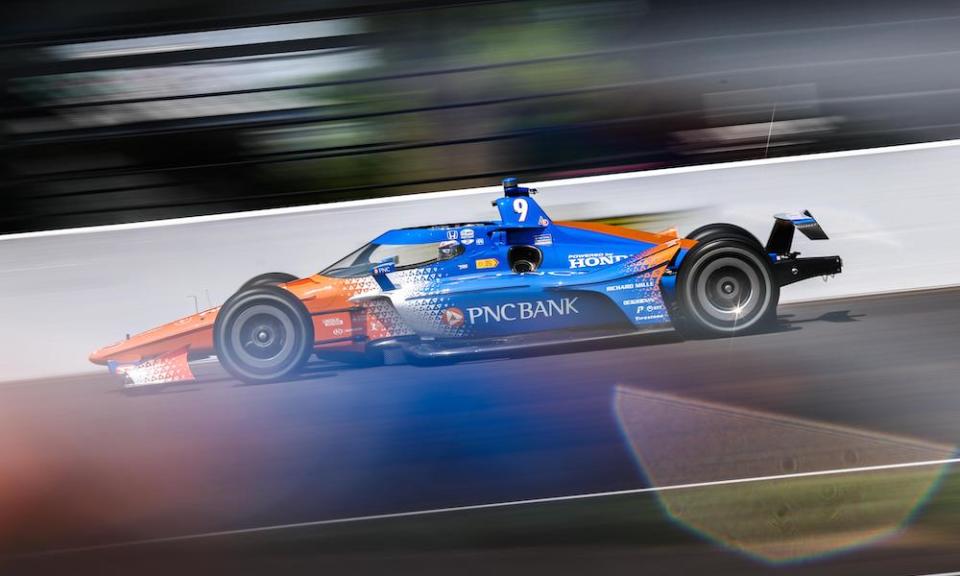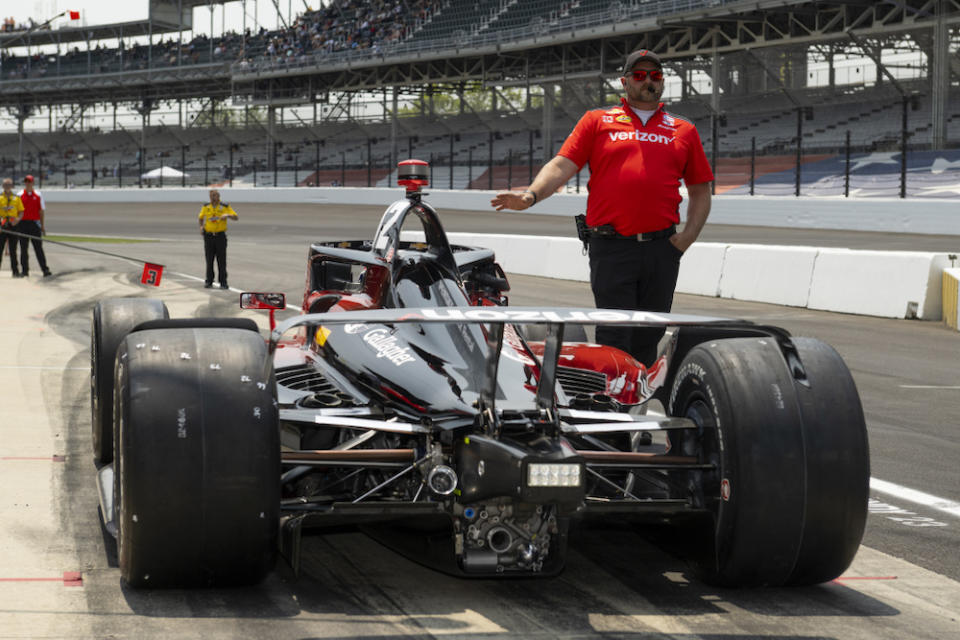IndyCar tech download: Indy 500 qualifying

A qualifying run at Indianapolis is one of the most intense engineering projects in motorsport.
Indianapolis Motor Speedway is hallowed ground to everyone involved in racing, but to engineers it is also one of the most idiosyncratic tracks that IndyCar visits. With its four distinct corners, extremely long straights, and season-high speeds, IMS is a different type of track even when compared to the other ovals. So on top of it being the most important qualifying on the calendar, it also has a different set of criteria when it comes to what the car needs from a setup.
Typically, a car is always limited in one of two ways throughout a lap: it can be either power-limited or grip-limited. To picture this, think of what the car would need to go faster in any given moment. If the car is at full throttle, it needs more power (or less drag) in order to go faster at that point. If the car is not at full throttle, it needs more grip (either for using more throttle when accelerating, or less brake when decelerating) in order to go faster. Any track can be broken down into a series of power-limited and grip-limited sections that make up the entirety of the lap.
Qualifying at Indy, however, requires a slightly different approach. Conventional wisdom says that the best qualifying runs are when the driver is able to stay flat for the entire four laps. Given the definition above, one might suggest that a car is power-limited throughout its entire qualifying run, but that’s not entirely fair to say. Engineers will begin to change the trim level of the car, meaning they change the aerodynamic configuration in order to remove drag. The effect of drag reduction on lap time is enormous at Indy, given the high speeds and the length of the straights.
But what stops engineers from trimming as far as they can possibly go? Trimming the car of its drag also reduces its downforce, and eventually the car will reach a critical point when even the tiniest further reduction in downforce would force the driver to lift in the corners in order to avoid losing control. In this scenario, the car is just about to reach the point of being grip-limited.
The reason this is a such a unique situation is because if the car hasn’t been trimmed enough, then it will still be power-limited in the corners. If it has been trimmed too much, then it will be grip-limited in the corners. Cars that have too much downforce are easily flat for the entire lap, and therefore have too much drag. Cars that don’t have enough downforce are going to force the driver to lift.

For engineers, setting a car up for a qualifying run is about dancing on an aerodynamic knife edge. Motorsport Images
The perfect amount of downforce for a car is when the driver can stay flat, but no more downforce can be removed without forcing the driver to lift. At this point, there is no additional drag on the car other than what is needed to have sufficient downforce. Finding this trim level is where the difficulty of selecting the perfect aerodynamic setup for a qualifying run at Indy becomes evident. The ideal aerodynamic setup is on a knife-edge, where performance can be lost by missing to either side of the ideal trim level. The engineer will have to decide if a car is flat for the entire lap, is a further trim possible? However, if an engineer trims beyond the critical point and reduces downforce to the extent that the driver is forced to lift (or more likely, refuses to lift and crashes), then that is even more penalizing.
Setting up the car is made even more difficult by the fact that the exact amount of downforce needed is very hard to predict before running. Track temperature, air density, wind, and the car’s mechanical setup – among other things – are all influential in determining the appropriate trim level, and many of these are changing in real time during qualifying. Getting the trim level correct is so important, and needs to be so precise, that teams will take note of their competitors’ wing angles, debrief in coded messages on the radio during the cooldown lap to alert teammates that have yet to go, and will even change aerodynamic configurations while in line waiting for their turn to qualify if they think it will help them go faster. Engineers need to have a well-calculated prediction of what the ideal trim level is, but also have the savvy to decide together with the driver when they shouldn’t push their luck any further.
In addition to optimizing the aerodynamic configuration, teams will also use the weight jacker in a specialized manner for qualifying at Indy. In essence, the weight jacker is a hydraulic actuator that is mounted on the right rear suspension and is controlled by the driver with buttons on the steering wheel.
The driver is able to lengthen or shorten the rear right corner with these buttons, which will have two primary effects. First, it will change how the weight of the car is distributed to each tire. Second, it will change the rear ride height of the car. With regards to qualifying, the ride height effect is much more interesting. Changing how the weight is distributed across the four tires is helpful for adjusting balance, but the balance does not shift all that much in just four laps and drivers also have adjustable anti-roll bars to achieve largely the same effect if needed.
Lowering the rear ride height however, creates a drag reduction, which is at a huge premium in qualifying. Teams will set their ride heights as part of the aerodynamic configuration when trimming, but then will use the weight jacker to lower the rear as quickly as possible down the straights before returning the car to its starting position just before turning into the corner where the downforce is required. The result is a free drag reduction down the straights, but no downforce loss in the corners.
In qualifying, use of the weight jacker as a way to reduce drag has become prevalent across the entire paddock. In the practice days leading up to qualifying, drivers will experiment will how early they can lower — and how late they can raise— the rear in order to eke out every last bit of aerodynamic performance for their qualifying run.
Today, the teams will embark on what I consider the most intense day of the year. The speeds are up, the stakes are high, and the window to get the most out of the car over four laps is extremely small. Still, winning pole at the Indy 500 has been coveted by teams and drivers for well over 100 years, and the engineering challenges that it possesses only adds to its prestige.
Presented by:
Get access to genuine HPD-developed racing parts and take your vehicle to the next level.

 Yahoo Autos
Yahoo Autos 
